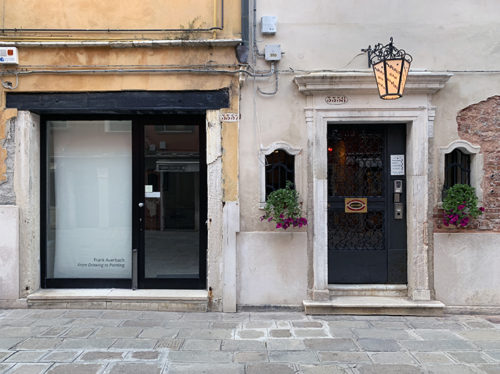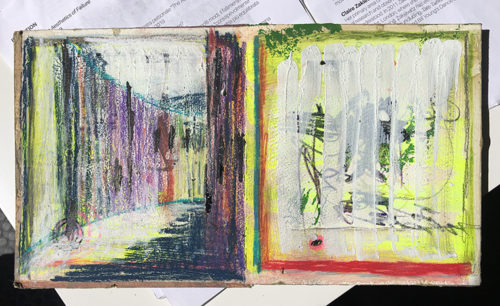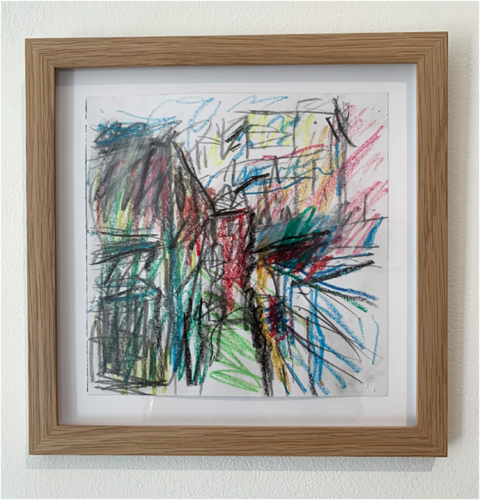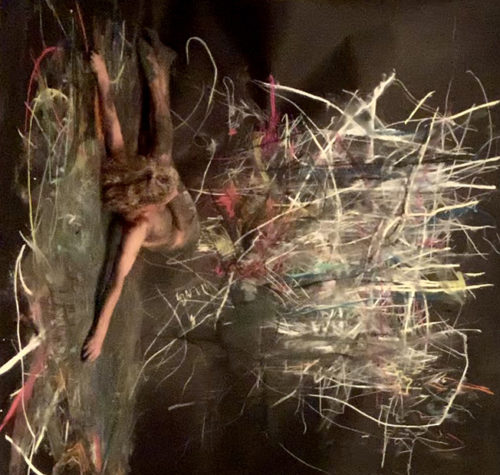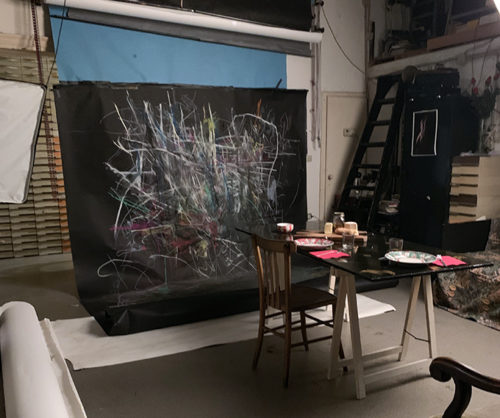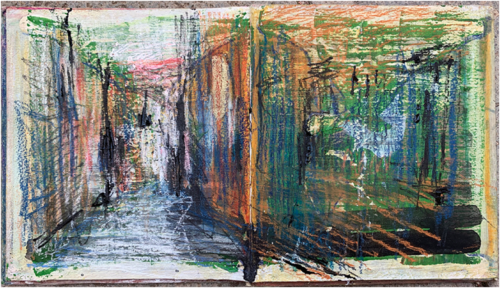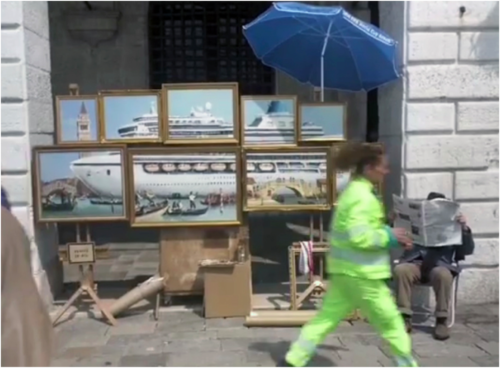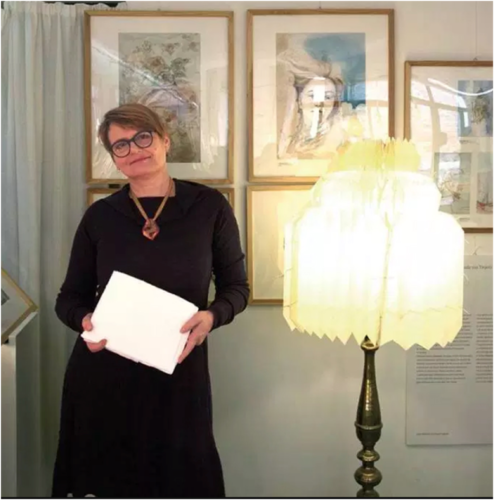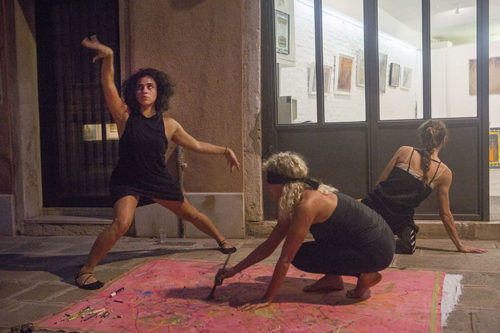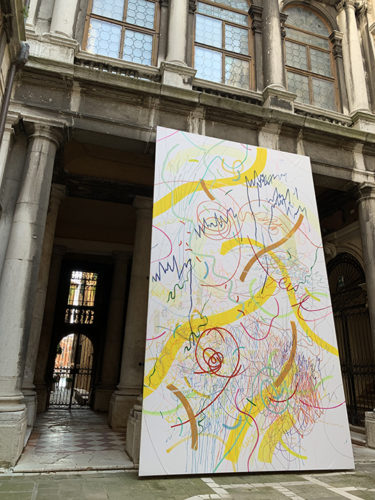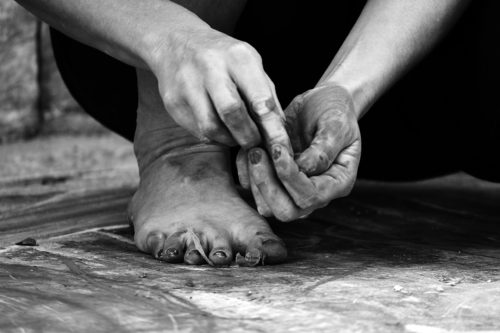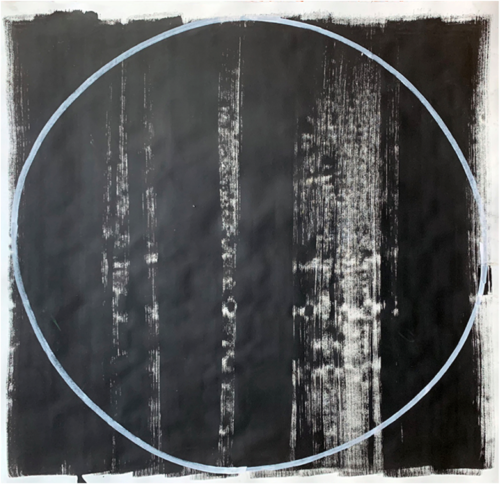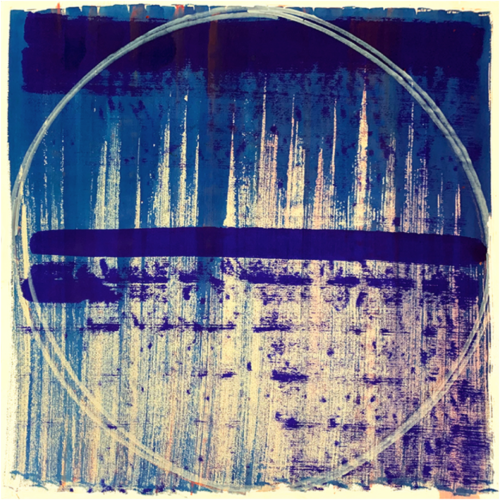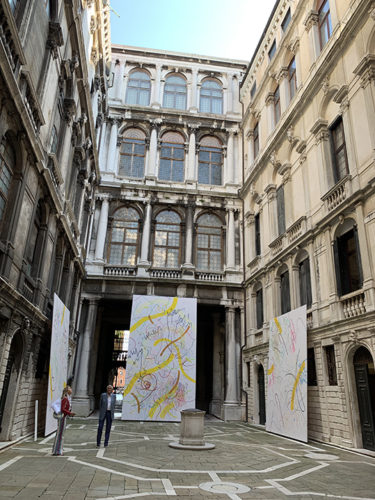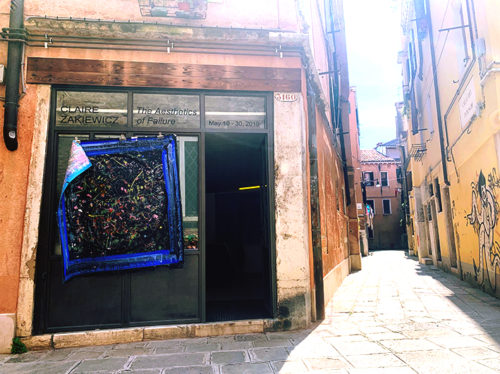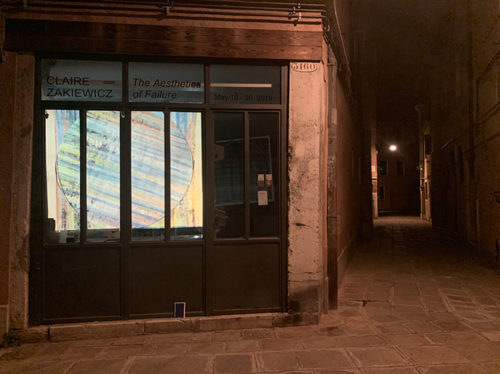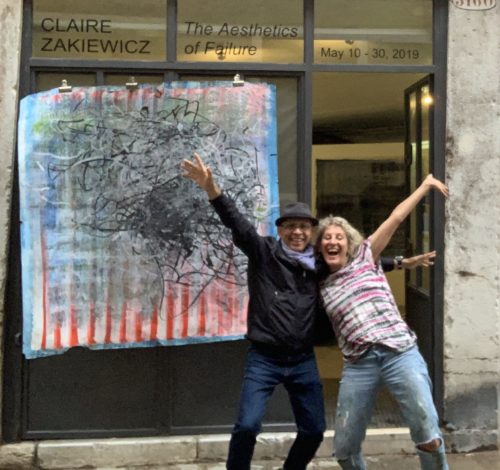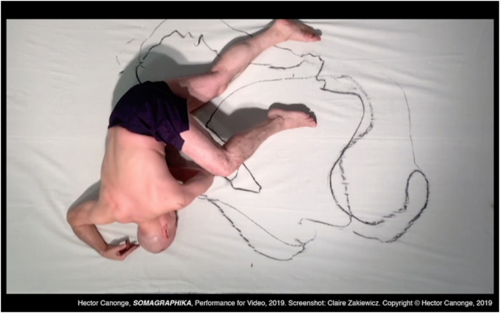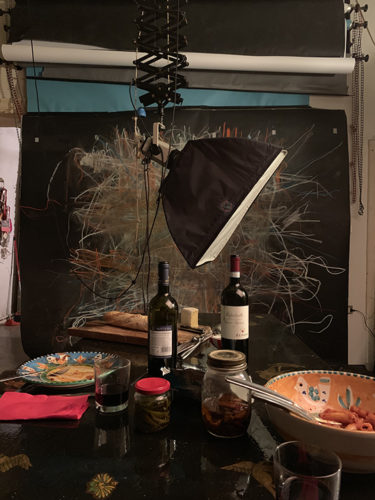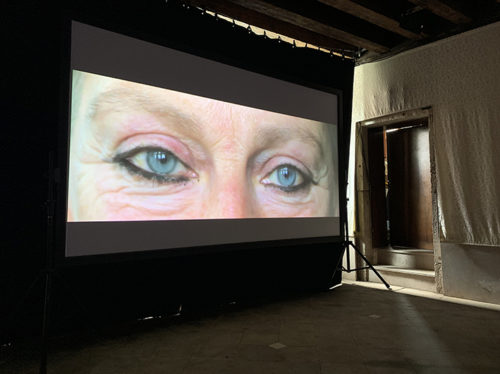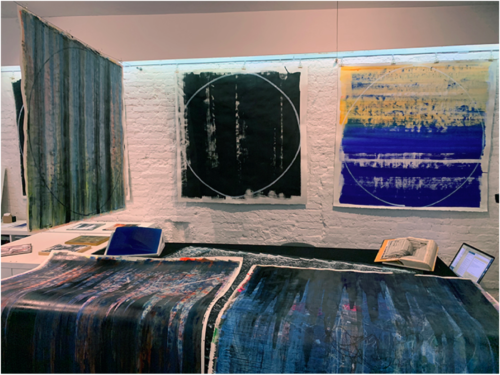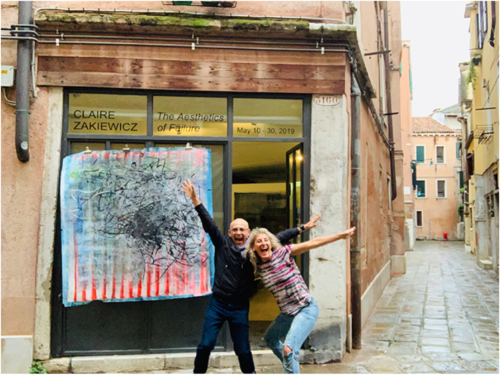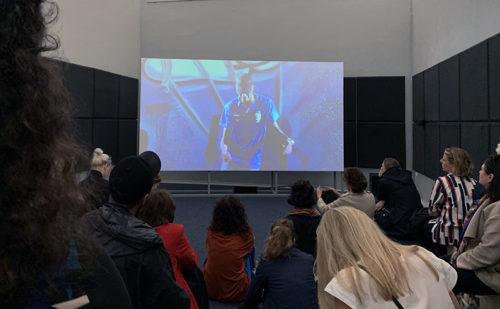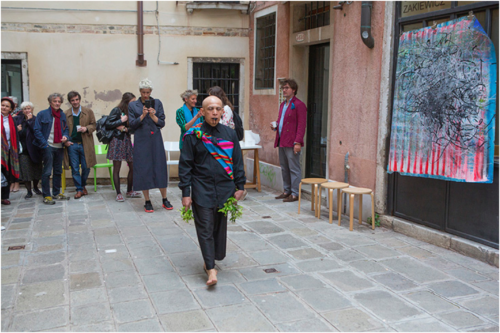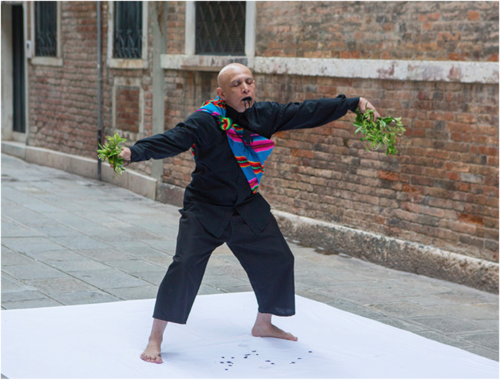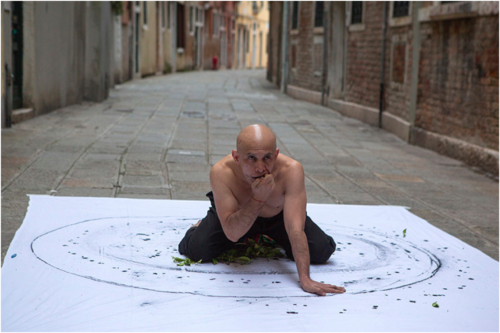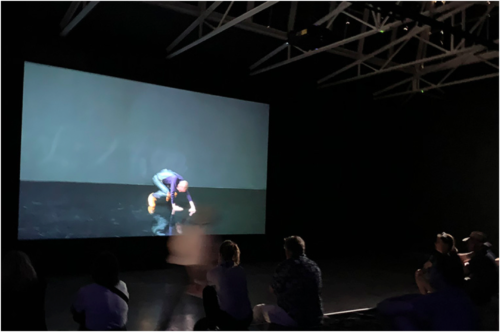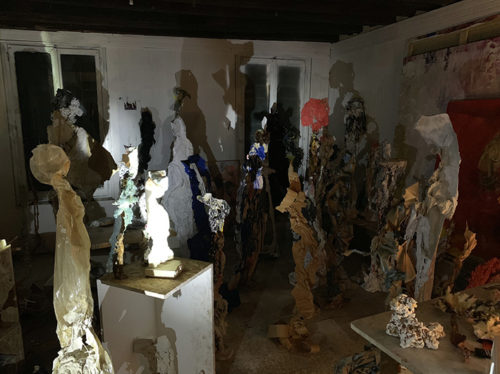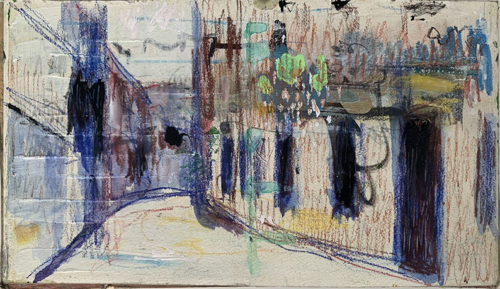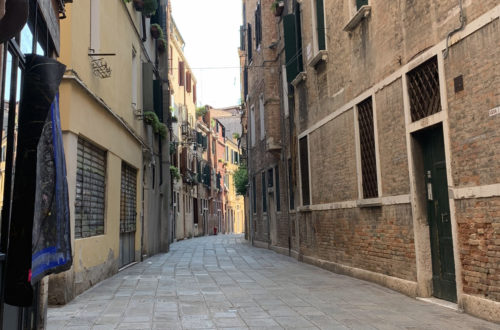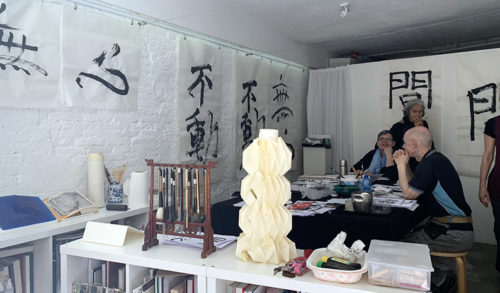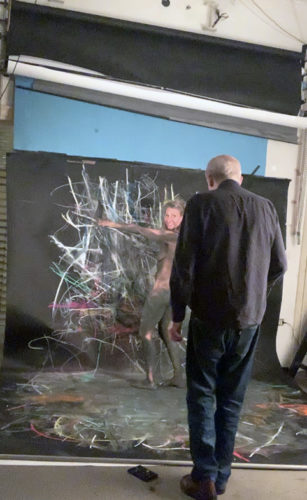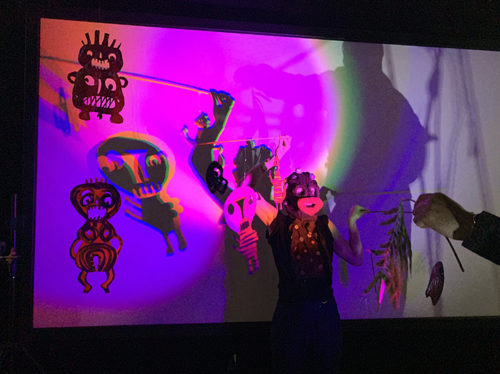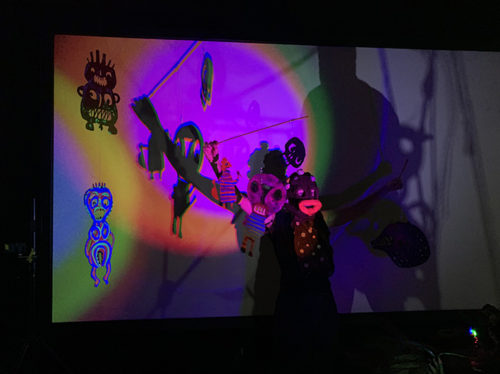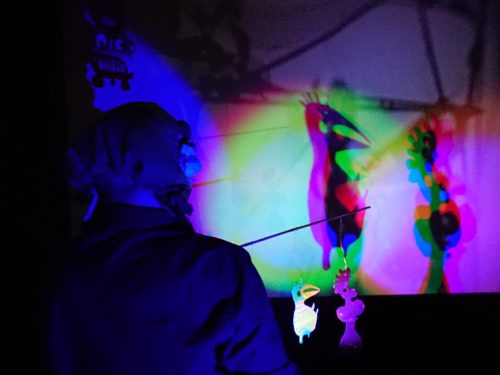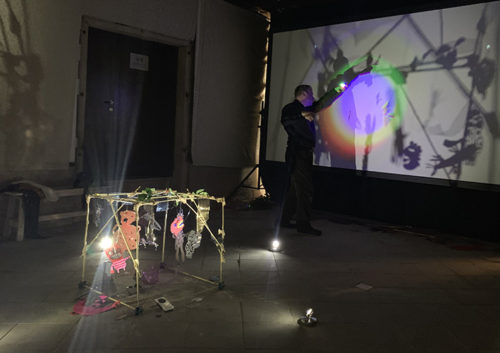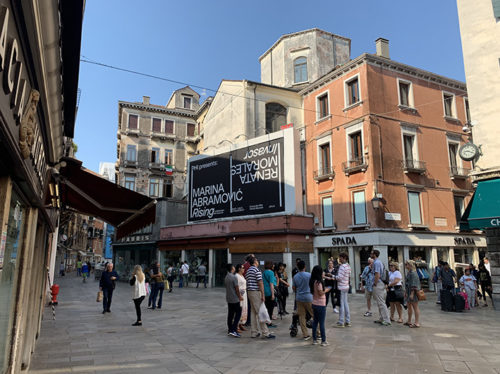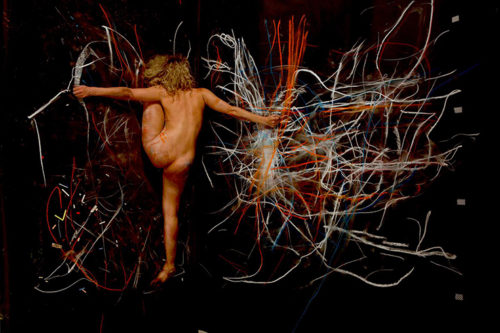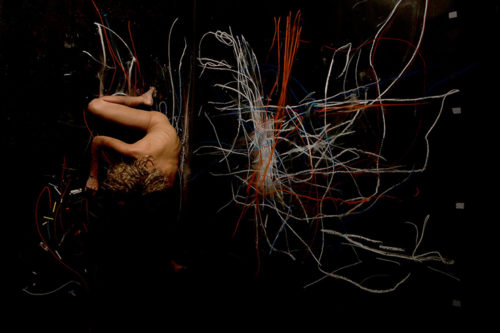May 21
I work in my gallery today. It is late-May yet summer hasn’t arrived and I still need the heater at my feet – although mosquitoes are starting to emerge. Various people come inside, some of who ask questions and leave their names in the visitor’s book. Anita, the gallery owner, is here and we chat about her plans to begin an artist residency in Venice and a new collaboration with arts manager Laura Vattovaz, who is just finishing her studies and works a few doors from the gallery.
The neighborhood is located in the central district of San Marco, which is mostly packed with tourists but our corner is a pocket for local residents. My gallery is just around the corner from tiny square of Salizada San Samuele, – with boutiques, ateliers and galleries. I am beginning to know most store and gallery owners here. The Alma Zevi gallery sits in the center and is currently presenting drawings by Berlin-born/London-based painter Frank Auerbach, for his first solo exhibition in Italy since he represented Great Britain in the 42nd Venice Biennale of 1986 – winning the prestigious Golden Lion prize. I am writing a piece on his works, of the gesture and its connection, both physically and metaphorically; to the contemporary art Biennale this year, which will be published here tomorrow.
May 22
On Salizzada Malipiero, along the street from my exhibition, Alma Zevi presents work by the British painter Frank Auerbach. He won the Golden Lion in 1986, when he represented Great Britain for the 42nd Venice Biennale and is named Britain’s greatest living painter by the gallery. I consider his work, practice and presence here. What I can learn from the acclaimed greatest painter in Britain and in what ways are his paintings so great? With his expressive gestures and wild color range, I make connections with my own works and also some of the other painters who have been selected in the main Biennale exhibition. The heavy, uneven, textural paint application, the messy gestures, the crooked forms, the unlikely pictorial resolution immediately draws me in. I imagine his lifestyle – drawing and painting the views from his studio, his neighborhood and models seems to suit who he is, what interests and motivates him. He is as prolific and active as his physicality will allow as he approaches 90 years of age.
The exhibition is titled From Drawing to Painting and I go into the gallery with collector and curator Caroline Wiseman who tells me about Frank Auerbach and his practice. The small works on paper almost look like abstract scribbles but actually depict the same city scene just outside his studio in central London last year in 2018. Repetition features heavily in his work. The artist, I am told, returns to the same locations day after day, year after year and has painted some of the same models on a weekly basis for over thirty years – on a constant quest, I hear, to find resolution. This repetitive process results in Auerbach developing intense relationships with particular subjects – people as well as locations. His gestural mark-making builds up in layers with a wild and, what seems to me, improvised color palate, often repeating the same scene multiple times with a different sets of colors, crayons, graphite, ink and felt-tip pens. Very musical and improvisational, I think. Auerbach is an excellent scribbler.
Gesture is something I explore in my own work as it connects drawing, music and dance. Gestures are forms of vitality – spontaneous, intuitive but also shaped by conceptual metaphors – which present a figurative comparison in which one idea is understood in terms of another. Action paintings of the Expressionists, were described by art critic Harold Rosenberg in 1952: “The gesture on the canvas was a gesture of liberation, from value – political, aesthetic, moral’, and his essay was instrumental in helping audiences and collectors embrace this new process-led approach all those decades ago.
My own focus on the scribble also felt like a way to shake off what I had been taught about drawing – trying to be precise, beautiful, clever, refined, resolved, acceptable. I wanted to un-learn the movements connected to my own identity, my prescribed patterns – or to see whether that was possible. I wanted to reduce drawing, at least for a while, to a minimal practice, exploring modes of perception, aiming to be present, to find a timeless moment and to examine my intuition and instincts.
Gestures, of course, are not only shaped by conceptual metaphors. Gestural mark making can be improvised, performative and temporal, cohering out of the body, vitality, noise and objects whose presence and significance extend across multiple modes of perception. Improvised gestural forms have a visible sense of spontaneity, balance, symmetry and flow. They feel very different to self-conscious and perfected ones. The difference is difficult to describe but I think it is the same difference between a self-conscious actors compared with somebody acting with their attention outside of themselves. Drawn marks reveal a state of mind.
Auerbach throws 90% of his drawings away so the selection on display has been highly edited and curated. Ultimately the works function, for him, as studies for a painting and give the viewer an insight into his process. There are many other contemporary artists this year – in the Arsenale and Central Pavilion of the Giardini, curated by Ralph Rugoff, whose works reflect an exploration of physical gesture, felt meaning, perception and intuition – a painter that immediately springs to mind is Julie Mehretu. The difference is that her process reflects the use of digital technology alongside gestural hand-made methods. There are many other artists whose work deals with technological advances. I have stop-motion animations playing in my solo exhibition as well as the group exhibition Alive in the Universe, that were created with unhealthy hours in front of a computer screen day after day for many weeks but I got an injury, having been a very active ultra marathon runner, from actually sitting in front of a computer for so many hours and I believe it’s a deeply unhealthy way to be living. Now I keep my process away from excessive time in front of computer screens and in dialogue with my own body, connection and collaboration with other human beings, in direct dialogue with them and the natural world. It seems like a luxury to be able to do this – I worry whether this will become the lifestyle only the mega-rich of the future will be able to afford.
My scribbles are usually a depiction of a musical piece (or noise) and the methods I use to create them include acting and dance techniques. There is a primal, universal and also introspective aspect to my method. When I feel that a drawing is resolved, it is sometimes comparable to the feeling of resolution in music after a period of tension, such as when a DJ finally drops the baseline the dancers have subconsciously been waiting for. However, unlike the experience of music, resolution in visual art is often less physical and more difficult to recognize. This is one of the reasons why, like Auerbach, I edit and analyze separately from the drawing process. It often seems that the harder I try in drawing, the less compelling a work becomes: as Giacometti said, “The more one works on a picture, the more impossible it becomes to finish it.”
Inspired by Auerbach’s drawings I spend ten minutes in the sunshine drawing the scene outside my gallery in a hand-made sketchpad Anita gave me in 2017. I have already filled the book with layers of experiments, which are now going to be backgrounds. Until the end of my exhibition I will draw the same scene repeatedly in another attempt to find resolution. Looking at my drawings next to Auerbach’s, it is difficult to explain how his drawings are so much more resolved but they seem to chime and resonate. In contrast Julie Mehretu’s paintings, while visually and conceptually compelling, have the slickness of computerized drawings.
Later this evening I go back to Mark Edward Smith’s photography studio to perform another drawing onto an enormous black photography backdrop – it is the same size as the drawing I made with him last Monday, which was on a white backdrop. These are the largest drawings I have ever made and having this space to move so much more provides the opportunity to expand on my usual drawing methods and documentation. I have included my own rough documentation here. In case you would like to read more about the specific drawing techniques I am using for this project, go to the diary entry for May 19.
May 23
Today I wake up early to meet the artist Anita Cerpelloni, who is also the owner of the gallery where my exhibition is showing. Anita works with calligraphy, painting and with paper – sculpting with paper, folding paper, making her own sketchbooks and bindings by hand – even making her own paper. She builds huge lampshades out of folded paper and exhibits them in hotels and design fairs around the world. Two years ago she gave me a sketchbook that she made which I have prepared with background layers. Resolution has been difficult because I want to complete the book with drawings worthy of the book itself. Inspired by the works by Frank Auerbach, which are exhibited at Alma Zevi – a gallery very close to Anita’s gallery, I have started drawing the scene outside the gallery on a daily basis. By the end of my exhibition, which is Thursday May 30, the book should be complete. The difference is that his drawings are highly edited and mine are going into the book unedited. I feel the pressure but I draw with improvisation in mind. I am tired today and the drawing is probably not going to be as ‘good’ as when my mind is sharp – but I’m working without judging. The show is called ‘imprecision’ after all.
Two years ago I also produced a series of double-sided drawings for my exhibition Out of the Mothership. Anita and I made plans to create a book with the drawings using hand crafted bookbinding methods. Today we work to complete this book. She shows me a bookbinding book, which explains how to bind with bird feathers and other such things. Our plan requires foraging for materials so we decide to meet again tomorrow.
The problem with waking up so early is I’m ruined for the rest of the day.
I spend the last few moments of sunshine with a take-away pasta from Tuttinpiedi (On your Feet), which I try to eat in St Mark’s Square. I hadn’t read the signs that sitting and eating in the square is not permitted and I am told to move on. I transfer my picnic to an acceptable location by the waterfront. I see on social media that Banksy is in Venice. His stunts are going viral. He set up an arrangement of paintings depicting a typical touristic scene of Venice except with a huge cruise ship going across them. There is a humorous video on his official Instagram account of setting up his display in St Mark’s Square and being asked to move on – possibly by the same guards who asked me to move. His Instagram caption reads, ‘Setting out my stall at the Venice Biennale. Despite being the largest and most prestigious art event in the world, for some reason I’ve never been invited.”
I chat to a friend about art and popularity. What makes good art? Will Banksy ever be curated into the Venice Biennale and if not, why not? His works are so popular and his stunts are quick to go viral. His works sell for more than $100,000. I remember an intern at the British Pavilion scoffing that people were asking her whether Banksy was representing Britain this year. Is it snobbery preventing Banksy from being accepted? I wonder whether there is a particular quality or characteristic that defines great Art. Neurologist Semir Zeki believes that high levels of ambiguity are needed to make works of Art great. There isn’t much ambiguity in a Banksy’s cruise ship paintings – essentially they are clever tricks with a fairly obvious message. Could that be the answer?
Sharon Kenny from Porthole Cruise Magazine meets me at the gallery in the afternoon for an interview. She explains how cruises ships get bad press in Venice due to the over-tourism when in fact; cruisers make up a much smaller percentage than tourists coming in on airplane, bus and train. It is easy to target the cruise ships because they are so visible and such a blight on the Venetian views when they are juxtaposed next to the relatively miniscule traditional Venetian gondolas, (as Banksy has highlighted).
I manage to work during the evening until 2am. By that time my exhausted brain is wired with adrenaline. I cancel all my plans for tomorrow morning and I ask Anita if we can take a break with the book – continue next week so I can think about what to do and also to rest. At the moment I feel like I am doing an ultra-marathon – my wellness, sanity and happiness is almost directly related to getting enough sleep and eating well at the moment.
May 24
Today I manage to sleep enough and I’m full of vitality and optimism. Summer has also finally arrived. I meet my friend, the wonderful Venetian-based dancer and artist Laura Colomban, who is prolific and intrepid, she just completed a residency at in Canada’s Banff, at New York’s Mothership and Laura sometimes performs with my improvisation ensemble Assembly. We performed together numerous times last September in Venice during my exhibition Perspectives in Motion.
At the moment Laura has a solo project called NEU MA that researches the body as an instrument and the breath as control. She says, ‘The main interest of this research is to connect the physical manifestations to new technologies, transforming the performer into a complex interactive tool.” Recently her research has moved towards the octopus intelligence and the theme of waste. She is also starting a new project, releasing a weekly video titled ‘Unemployable’ with a sensory/embodied/body-based experience of her state now as a dancer.
For more information visit: https://www.lauracolomban.org/
May 25
It is Saturday, the sun is out and Venice is buzzing with visitors for the Biennale. I chat to people all day at the gallery and also write an invitation for my closing reception, which will be next Thursday May 30 from 7:00 – 9:00pm.
My exhibition, IMPRECISION: The Aesthetics of Failure includes drawings, a video projection, performances and an essay. It examines the tensions between failure and perfection: the techniques, limitations and the implications – in particular improvisational processes. In my drawings, I’ve noticed that aiming for something ugly can produce beauty. Failure creates new pathways; it disrupts prescribed patterns. Drawing blindfolded with one’s attention on something other than the drawing, almost always produces a quality of line, unity and balance of shapes – even – or more prominently, as control moves further away.
I have been asking: What is failure? How does failure relate to imperfection? We often think of failure as the opposite of success, however in many ways, failure can be associated with eliminating expectation or a state of not ‘consciously’ aiming for pure perfection. Embracing ‘failure’ per se can often lead to a more balanced symmetry. So, is failure the resolution?
Alongside my solo exhibition, a selection of my video works are featured in Alive in the Universe, curated by Caroline Wiseman and David Baldry at the Palazzo Pesaro Parafava, Venice until June 5, 2019. The exhibition includes artists from varying disciplines such as Sarah Lucan, Julian Simmons, Maggi Hambling and Eileen Haring Woods. For more information go to www.aliveintheuniverse.com
A PDF of my exhibition catalogue can be downloaded at www.clairezakiewicz.com, a selection of the drawings on display are listed at www.clairezakiewicz.com/venice.html and you can follow my instagram page at @clairezakiewicz
This week a prominent performance artist from New York, Hector Canonge, is flying over to perform a piece created especially for the exhibition titled SOMAGRAPHIKA, a project that explores the spatial relationship of drawing and corporeal movement. Through a series of actions, Canonge creates a canvas where lines of charcoal recreate the various shapes of his continuous performative movement. The project consists of a performance made for video, which is being screened at Alive in the Universe and a live presentation at the finnisage of IMPRECISION: The Aesthetics of Failure, where the artist captures a series of bodily impressions delivered over a period of time.
IMPRECISION: The Aesthetics of Failure is open daily this week until May 31 from 1:00 – 7:00pm at: ARTI3160, Salizzada Malipiero, San Marco, 3209/A – 3160, Venice, Italy
May 26
Yesterday I saw an exhibition called The Spark Is You, at the Music Conservatory, (Conservatorio di Musica Benedetto Marcello di Venezia) in Campo San Stefano.
The Conservatorio di Musica is buzzes with music students and always seems to present an exhibition during the Biennale that I consider one of my favorites’. As well as this, they have an outdoor courtyard that is perfect for contemporary art performances. I recall the fantastic exhibition of sound paintings by Breezy Baily and Brian Eno titled The Sound of Creation in 2015, whereby Baily had responded to musical pieces by Eno. Visitors could put on headphones and gaze at the works while listening to each musical piece. The paintings were vibrant, abstract and gestural and placed up the stairwell and in little rooms like a treasure hunt.
This year contemporary classical music fills the outside and inside spaces. It is an exhibition that presents work by nine contemporary Iranian artists. The artists were selected for the affinity with openness, respect and human interconnectedness that is evinced in their work and this theme is in line with the zeitgeist running through the Biennale this year. The show curated by Ziba Ardalan, who is the founder, artistic and executive director of the foundation for contemporary art, Parasol unit and the exhibition is one of the Biennale’s Collateral events.
There are many fantastic works that are installed in the outdoor courtyards and also in numerous rooms on the second floor of the stunning 17th Century building. The works that appeal most to me – because of their immediate connection between sound and drawing, improvisation and composition, the hand-made and the manufactured and the clever dialogue with the space, are a triptych of huge large-scale paintings by David Nuur (born in 1976 in Tehran and now living in The Hague, Holland) titled The Tuners. The works lean against the courtyard walls presented as objects, rather than pictures. Music fills the space and I wonder whether the piano and horns are being played by live musicians or are recorded and so the same music is always heard. There are open windows high up in the square courtyard and I wonder which it is coming from. The acoustics make the source difficult to determine.
Gestures connect multiple time-based disciplines such as drawing, music and dance. They are forms of vitality – spontaneous, intuitive but they are also shaped by conceptual metaphors, presenting a figurative comparison in which one idea or object is understood in terms of another. Action paintings were described in 1952 in an essay by art critic Harold Rosenberg: “The gesture on the canvas was a gesture of liberation, from value – political, aesthetic, moral.’ This essay was instrumental in helping audiences and collectors, in particular, embrace this new process-led approach of the Abstract Expressionists. Gestural drawing still seems increasingly present in contemporary art and this year at the Biennale artists such as Julie Mehretu, Frank Auerbach, David Nuur, and others explore conscious, unconscious and automated mark-making by machines or animals. I would argue that this is due to an increasing interest in the nature of consciousness, cognitive processes and our emotional relationship with art – which perhaps is due to technical developments fueling our understanding of these topics in the arts, humanities as well as in the sciences.
Nuur’s paintings depict what the exhibition describes as randomly painted doodles, informed by the unconscious or consciously made marks that people leave behind on the counters of stationary shops after trying out various pens. Nuur collected these test papers in various countries around the world and was struck by a similarity – usually no words, symbols or pictures but similar squiggly strokes. Nuur transferred these pen marks to canvas by marker. The title The Tuners, makes reference to the test marking. There is something primal about the marks and a universality that unites us. Nuur asks, I read, why national boundaries separate us – no matter where we were born or now reside, we are all the same.
Parasol unit sits beside Victoria Miro gallery in Shoreditch, London (who opened their Venice gallery two years ago in 2017). I can’t help wondering whether the two galleries conspired in their presence in Venice during a friendly coffee break, as there are very few international art galleries with permanent spaces in Venice. Unlike Victoria Miro, which is a private commercial gallery, The Spark is You is a collateral exhibition – these run alongside the main curated exhibition and international pavilions whose proposal to the Biennale Arte was submitted (by October the previous year) and accepted. The Biennale then helps with advertising and grants permission for the organizers to use their red lion logo. There are many other events, exhibitions and projects that are not officially supported by the Biennale, but are often just as high standard. In fact some of the best exhibitions that I have seen in Venice were not part of the official Biennale nor collateral events but were privately organized and funded, such as Intuition, at Palazo Fortuny in 2017.
The Spark is You runs from May 9 – November 23, 2019 and is open everyday except today – Sunday.
May 27
The Venice Biennale is the world’s oldest art show which exhibits some of the most prominent artists from around the world. Performance Art has been increasingly part of the Biennale just as it has out there in the Art World. Two years ago in 2017 Anne Imhof’s performance piece ‘Faust’, won the prestigious golden lion award at the German pavilion. This year the Lithuanian pavilion won the award with the performance piece by collective Neon Realism – a contemporary opera performance titled Sun & Sea.
This year, for the first time, there is an official programme of fifteen performance works in addition to performances in the national pavilions and off-site project spaces. This initiative has been co-devised by the Biennale curator Ralf Ruggoff and Aaron Cezar, director of London’s Defina Foundation as part of the Biennale’s public programme (‘Meetings on Art’). This programme is scheduled to take place between May 8 – 12 and November 22 – 24. The performers for the ‘Meetings on Art’ programme represent a diverse range of nationalities and include, Polish artist Alex Baczynski-Jenkins, London-based Florence Peake and Cooking Sections, Nastio Mosquito, a composer from Angola and Canadian drag queen Victoria Sin. I have been working between London and New York for the past five years so I am particularly involved with the performance art scenes in those cities. New York, in particular still has a vibrant, established and underground performance art community which has been thriving since Yoko Ono, Nam June Paik, Yayoi Kusama and a young Marina Abramovic really created and pushed the form back in the New York happenings in the 1960s. Some of that energy certainly still exists in New York.
Today I am preparing for the arrival of a friend and colleague who is a prominent performance artist and curator from New York, Hector Canonge, who is arriving in Venice to perform apiece created especially for my off-site project titled SOMAGRAPHIKA. The project consists of a performance made for video, which is being screened at Alive in the Universe and a live presentation at the finissage of IMPRECISION: The Aesthetics of Failure on Thursday May 30 at 7pm, where the artist captures a series of bodily impressions delivered over a period of time.
I know Hector because he created and runs the annual Performance Art Festival of NYC, ITINERANT – 5 days of performances in 6 locations including The Queens Museum, Smack Mellon, Grace Exhibition Space and the Last Frontier NYC. Last year I performed with the artist, actor and vocalist Siw Laurent at the Last Frontier, which is run by the visual artist Sol Kjøk – a true legend in the New York arts scene who runs the residency space The Mothership as well as The Last Frontier.
Immediately after the ITINERANT festival in 2018 I took a bus with Hector to Rosekill – Jill and Erik’s outdoor performance art venue in Upstate New York, for the Panatheaia Festival that will be forever in the minds of everybody who was there. The performances were wild and wonderful and many artists stayed up creating and talking all night by the fire. We camped or crashed out in hammocks, skinny dipped in the lake and sweated in the sweat lodge. Rosekill is an idyllic creative haven for performance artists.
Canonge is currently developing new work to be presented in the X Encuentro of the Hemispheric Institute of Performance and Politics in Mexico City (June 9 – 15), and for his solo exhibition “Impulsos” at Museo Casa Melchor Pinto in Santa Cruz de la Sierra, Bolivia (August 3 – September 10, 2019).
IMPRECISION: The Aesthetics of Failure is open daily this week until May 31 from 1:00 – 7:00pm with the finissage on Thursday May 30, 7:00 – 9:00
ARTI3160, Salizzada Malipiero, San Marco, 3209/A – 3160, Venice, Italy
May 28
Although it is the final week of my exhibition IMPRECISION: The Aesthetics of Failure, it is still a priority to visit other exhibits on most days, especially when the artist is somebody I know and I am able to meet them with their work.
Today Eileen Haring Woods, an artist from New York living in Suffolk, England, is showing her two-screen video piece I Look To You at the exhibition Alive in the Universe, at the Palazzo Pesaro Parafava, Venice. I head over there under an umbrella before opening up my gallery. I’m very glad to have made that effort. It’s a beautiful 15-minute work that evokes a sense of contemplation on the theme of interconnectedness. A close up of a pair of eyes is projected onto both screens, which face each other. The eyes change, an older pair, a shy pair that looks away, a young set of eyes gaze definitely, a middle-aged woman with mascara and eyeliner. The eyes are saying so much, revealing too much, perhaps. It’s a piece that causes me to reflect on our vulnerability, the impulse to hide our true selves yet our need to connect and to be seen. It’s a poignant piece during this time of social media and technological advances, which has been dubbed the age of loneliness. How open do we allow ourselves to be? A ceremonial, meditative soundtrack is played while the canal waters lap, rhythmically in the space of the palazzo itself. The piece is punctuated by a short animated interlude, which plays homage to sight, vision and communication with a 1930’s soundtrack by the artist’s grandfather, Bob Haring and his Orchestra, with an underscoring of ‘I look to you’ in morse code. I would have stayed to watch the work repeatedly in that meditative space, but I need to open my gallery. I ask Eileen a few questions – did the people in the film have any direction? How close was Eileen to the camera? Eileen has a background in theatre and the actor’s preparations were carefully crafted – exploring the notion of trust.
The exhibition Alive in the Universe includes artists from varying disciplines exhibiting for one day in the back room of the palazzo – such as Sarah Lucas, Julian Simmons, Maggi Hambling and Eileen Haring Woods. In the front room, three monitors play short films by artists such as Scotto Mycklebust, Hector Canonge and I also have a six 1min video works, which are screened every day until the end of the exhibition on June 5. For more information click here.
I am back at my own gallery and the rain continues. This evening I am working again with the photographer Mark Edward Smith – taking more photographs of a live-drawing performance. My energy levels are low but he work goes well and I am happy to spend the evening with Mark, who is full of stories and good humor. I have written about the work we are doing together on May 21st. There is a lot more to say but for now my focus is on making rather than reflecting.
May 29
I wake up too early and try to sleep more but I have an anxious feeling that is increasing the longer I lie so I get up. I am unsure whether I will perform tomorrow during my closing reception, or whether I will show a film, give a speech and present the performance artist Hector Canonge, who will be performing. I decide to prepare for any of these possibilities. I paint with transparent gesso over three of my large paintings, which can be used to paint onto during a performance. The gesso provides a good texture for pastel, ink or any other paint. Painting can often be a meditative practice for me. Especially when I am following a pattern. I work in a performative way with close attention to my breath and movement of the body. When I am finished I leave them to dry and go to the gallery. It is raining so I don’t expect many visitors.
I am anxious about the finissage tomorrow because I haven’t decided what I am going to do and I haven’t met with Hector yet. We have an appointment to meet in the gallery in the evening. The main motifs for this exhibition are the circle and downward linear gesture. I call them breath drawings. The idea was to translate architectural structures – line, form and symmetry, found in the distinct cities of New York, Venice and London – the places I have been living and working between over the past five years. Each line represents a fluctuation in rhythm and density. The verticality represents energy and growth; the horizontal lines provide a sense of stability and reflection. The works become a geographical typography that visualizes both kinaesthetic and sonic movement. I layer each composition responding through gesture to sound, notation, memory or I follow a prescribed pattern, relating to duration. The durational aspect is created by the connection between the brush stroke and the attention to breath. It is a calming and meditative practice and today I produce many new pieces.
I have more visitors coming into the gallery when I hang a brightly coloured painting outside and have the door open. Today I want to work alone, to be with my thoughts so I have the door closed but people do come in – with their wet umbrellas and they seem interested that I am working, taking photographs. Some of Anita’s friends – Japanese artists have come to see the show. They must have noted that it closes tomorrow and I feel like I am part of this tremendous international community that has gathered here in Venice during Biennale time.
I make my own watercolor today with black pigment and a binder, which I have bought from the local art store. I have never used this particular binder and it dries much slower than I expect. I spill some paint onto one of my favorite paintings. I think about the title of the exhibition. IMPRECISION: The Aesthetics of Failure – I am a sloppy painter. Disruptions are so common in my work that learning to embrace them seems the only way to develop my practice. I’m not sure how I can turn the spillage into a positive development but at least I make sure no paint gets onto the floor or table. I use the paint to make a lot more paintings than I intended.
When the works dry I rehang the show. I am happy with some of the new works.
Hector arrives. It is always so great to see a familiar face in an unfamiliar setting. We go for an excited dinner and make plans for tomorrow.
May 30
I wake and try to let myself sleep for longer but anxiety creeps into me like it did yesterday and I realize the best thing I can do is to get up and get to work.
I go to the gallery and wonder how I will shape the closing reception. Will I perform, play a film or give a speech? Again, I decide to plan for either of these possibilities. I keep on having ideas and then ditching them. I play some drumming music that seemed to be open source from an app – shaman drumming for journeying – and I play it over and over while preparing in the morning. I decide against using it for a performance but perhaps the drumming set the scene for the day.
I go to the gallery carrying a roll of paintings on my shoulder, the weather is overcast but the forecast has promised a dry day. The crowds between San Marco and San Stefano are thinking and my roll of paintings is long.
I decide to edit some of my films to screen during the closing reception and also play around with a musical track that I composed a few years ago – drawing onto a drum in response to a friend’s table drumming – but this work causes my computer to freeze for the rest of the day and it doesn’t work properly until half-way through my closing reception. The Aesthetics of Failure turns out to be a comforting name for the exhibition today; learning to embrace failure is truly helpful.
A friend arrives and we go for a coffee. Coffee turns into prosecco as we meet another friend who is celebrating her birthday. They advise me on deals for this evening’s supply of wine and snacks and I manage to borrow an ice bucket.
Sitting back at the gallery I make the decision not to perform and I immediately relax. It is becoming increasingly apparent that many friends are making the effort to be at the event this evening. Giving a speech, showing video works and supporting Hector seems right. As it turns out I would have had one of my most captive audiences but I made the right decision. We had 10 -15 people who arrived for the performance at 6:30 – even though the start time was advertised for 7:00, some came to give me a hand. That touched me. I am interviewed about my work by one of Anita’s friends, which is filmed. By the time the performance was due to start – at 7:30 I was keen for it to start promptly. My experience in Venice has been that people expect a prompt start otherwise they get tired of waiting.
Hector arrives at 7:00 and is very surprised to see the small crowd. We still need strategize logistics and see how the white surface is going to look on the pavement, which he will be performing and drawing on. I have Mark’s huge white photography paper and we lie that out in the street. Hector prefers the white fabric that he has brought with him. The plan we settle on is for him to go to Campo San Stefano, which is 3 minutes away then a few minutes later I ask the small crowd to go there – following the photographer Mark Edward Smith. Another friend helps with sound – she is playing a soundtrack using Bluetooth and Hector has a travel speaker clipped onto his costume. I wait at the galley in case more people arrive while they are gone. Four people choose to stay at the gallery. Six of seven more friends arrive and choose to also stay at the gallery. We wait and wait and begin to worry. Perhaps Hector has taken a wrong turn. Eventually – after about 30 minutes I hear the strange soundrack and I go around the corner to see. Hector walks – very slowly towards the gallery with black dripping from his mouth. He has the full attention of the street and people have their telephones out filming fixated on the spectacle. When he finally arrives by the gallery he performs onto the fabric, which is set out in the street. Hector drew circles in a very ritualistic manner and the black charcoal that he crunches in his mouth drips. It seems at once Medieval and futuristic. His performances, as he describes them, mediate movement, endurance, and ritualistic processes.
As the strange music stops the sounds of the street were even stranger – a seagull and a baby crying – screeching in the sky above fits perfectly with the intense performance finale.
I give a speech, introducing Hector, his work and the festivals he puts on all over the world. I talk about the ideas behind the performance, which is called Somagraphika. He then explains further that the idea was to evoke and invoke the processes of creation from within, from the body and how this work connects with my exhibition.
I then say some thanks to Anita and others who helped and invite everybody to join us in drinking up the prosecco and celebrating the finissage.
May 31
I wake at 5:30 and I watch the sunrise. I think about the closing reception that happened last night and I feel great that it is all over. Months of preparation, anticipation, anxiety, overspending has almost come to an end. I enjoyed the evening, and there is much to reflect on. I cannot go back to sleep again. Music on, I dance and enjoy some tea. I have left everything useful at the gallery – laptop, sunglasses. I have arranged to meet Hector to visit the Biennale at 9:30 which gets moved back to 10:30 so I decide to run over to the gallery, which needs to be cleared today. I take the 15 minute walk back with heavy bags full of books and my smaller paintings back to my apartment and by the time Hector and I meet under the astrological clock in Saint Marks’s square I am sweating. Hector has a bus to catch in 3 hours so we walk/run to the Biennale site of the Giardini.
The crowds are thick today but Hector is determined and sees most of the pavilions. I join him for most but take a few breaks on the grass.
There are two video installations featuring dance in the Brazilian and Swiss pavilions.
The Swiss pavilion presents a video-art dance protest. The floor, walls and ceiling are black and there is a glittery curtain that moves back revealing the screen – the scene is somewhat like a nightclub or studio for theatre or musical rehearsals. The music is trap and techno and the dancers respond in very different styles to the notion of moving backwards. The idea behind the choreography is political. A letter is displayed outside the pavilion reading like a manifesto that addresses issues of migration and closed borders. The piece draws from queer theorist José Esteban Muñoz statement “the now is a prison house. Backward is the new forward, or the other way around”. The work which is titled Moving Backwards is by Pauline Voundry and Renate Lorenz with 5 choreographers/performers: Julie Cunningham, Werner Hirsch, Latifa Laâbissi, Marbles Jumbo Radio and Nach.
The Brazillian Pavilion shows a two-screen work titled Swinguerra by video artists Barbara Wagner and Benjamic de Vurca. Swinguerra is a dance phenomenon in the city of Recife, where underground youth groups’ battle in dance-offs. Fusing hip-hop and samba, it’s an inclusive community of mostly non-binary dancers. The art crowd taps their feet at the infections rhythms as they watch the dancers grind and thrust.
I think of the materiality, universality and politics of movement. Using movement of the body as a means of expression is so primal – and light.
Today I am particularly vexed by the weight of my paintings and materials which I first need to move out of the gallery and then back to London. I don’t have any help. It’s fortunate that I am still fairly strong. I will not be able to work in the same way forever. I admire performance artists whose resource is their body and I would like to explore that more in my own practice.
Questions have been arising for me in my conversations with friends about performance and video art. When can a dance performance be presented as contemporary art rather than contemporary dance? How about drag acts? And the process of making a product – when and how can that legitimately be performance art?
For now I say bye to Hector, who goes on his way across Europe and I go to an exhibition opening of a local artist, Peggy Milleville whose studio is located in the same neighborhood that I have been exhibiting in, close to Salizzada San Samuele, underneath Mark Edward Smith’s photography studio. I see many of the locals, who have become friends and other characters who live in Venice or support her work around Europe. Milleville’s sculptures and paintings are between figuration and abstract gesture. It’s a beautiful, atmospheric installation that fits in her 14th Century studio building. The atmosphere is particularly special and in contrast to the tourist art crowds of the Giardini.
More to do today – there is a gathering of artists from the exhibition where I have been exhibiting some of my films – Alive in the Universe. We eat and drink at Paradiso Perduto until midnight and then it is time to finally go to my own gallery, to pack my things and carry my very heavy suitcase back to my apartment. I don’t wish to complain or get negative but this is the most difficult part of putting on the kind of exhibitions and projects I do. They are heavy with physical objects. The ultra-marathons I used to run a few years ago and the stamina I built up from doing them have been very helpful since I started making large drawings and paintings. It is that stamina that gets me home, over 5 bridges, up the last flight of stairs up to the 3rd floor by 2:30am. I remember that last stretch of a 50km run that I didn’t think I could manage – my mum ran with me and I only just managed to do it. That memory got me up those last few flights with my enormous case packed with framed paintings and panels.
June 1
Today I have to finish up the last bits of work at the gallery and also at Mark’s studio. It is hot and I walk slowly despite being late. There is some resistance in me around finishing up. Perhaps I really don’t want to leave, but I know I will be back in a few weeks. Anita has invited me to a workshop on June 22 and 23 and to also work on making a book together. I’m going to change the work that I left with her 2 years ago for the book project – update my ideas and work towards something new after this trip is over. Perhaps something reflective or a development on what I have done or otherwise something new. I discuss with a friend how the problem with art is that artists can do anything. Perhaps the trick is to find the thing that gives the most amount of energy.
I have finished the sketchbook inspired by the British painter Frank Auerbach, whose work has been showing the Alma Zevi gallery along the street from me. Like him, I have quickly sketched the scene outside my studio repetitively over a series of days as a means to get more connected with the subject. Perhaps I will turn these drawings into a painting. I have gifted the book to Anita, who made the actual book and gave it to me two years ago. It feels good to have completed it – even though I certainly could have continued working in it. Resolution is so hard to find – but I think about it – sketchbooks are never really meant to be resolved finished works. They reflect a process towards something – to get more familiar with a subject – a study towards resolution.
I need to buy fixative for the pastel drawings that I made in Mark’s photography studio before packing them away to be stored. The 2.75m x 5m works are possibly too large for a plane journey – especially as I have so much else to carry back to London. I will need to come back for them – perhaps with a van – later in the summer. Otherwise I will let Mark have them – he might be able to use them as backdrops.
I go to Anita’s gallery for my final job uninstalling the exhibition – taking my lettering off the windows. Anita is doing a calligraphy workshop and I pause there for 30 minutes. The teacher instructs me on how to do vertical and horizontal lines correctly, with attention on entering and exiting the line. I fill at least 30 pages. It is meditative and requires a great deal of control. We move on to Japanese words – torrent and moon, I almost feel that I have moved on too soon. I’d be happy to master the simple line before moving on. I make a note to self – keep practicing what I have learnt for my own line drawings. Although this exhibition was about imprecision, perhaps my next one could be the opposite.
I go to a dinner organized by the curators of the exhibition Alive in the Universe, which I am also part of with video works. The artist Shaun Caton’s and his friend Julius host the dinner. I also meet the artist Judy Goldhill. David Baldry, is there with his wife Sue Brinkhurst, and the curator Caroline Wiseman. Conversation is lively and stimulating. Shaun asks us all to take part in his performance at the exhibition tomorrow. I have never seen one of Shaun’s performances but I have seen his paintings online and I love them. I am excited to take part and dinner finishes fairly early so we can all be fresh for it.
June 2
I oversleep because my head was full of ideas all night. I am looking forward to participating in the performance with Shaun Caton – a performance artist who mostly works with painting and also creates performance-based, visual moving environments using light, shadows and painted cut-out characters that create scenes. Mixing painting and performance I am happy to get to know him and his work better. Looking at his website, he has a highly developed style, which I love. His paintings become puppets, or totems. He says that his ‘embyonic totems germinate from semi-automatic scribbles’. The titles are funny, clever and he is also a beautiful writer. Shaun talks of Art Brut, or ‘outsider’ art and he tells me that he works in an art studio in a psychiatric ward in Homerton Hospital – close to my home in London.
It seems that video and performance works have been particularly prominent in Venice this year. I have seen very little painting. On my way to Palazzo Pesaro Papafava, where Alive in the Universe is presenting Shaun’s work, I pass a billboard, which is advertising the performance artist Marina Abramović’s exhibition here. Her project is a virtual reality artwork at Palazzo Ca’Rezzonico. The last time I recall such large billboards advertising artist’s private exhibitions here in Venice was Damien Hirst in 2017. I can’t help wondering whether Venice showcases the best artists in the world or rather the most ambitious and prolific – with the willingness and ability to throw their money into their projects here – I recall Damien Hirst admitting that he spent more than 100 million of his own money on his 2017 project in Venice, which, I believe, he made back many times over.
When I arrive at the Pallazo, Shaun has already set up. He has a square construction in the centre of the room built with sticks, painted cut-out characters and leaves. There are four small lights on each side, which cast shadows onto the two projection screens. He also has shadow totems attached to sticks with tangles of wire laid out for the audience to pick up and participate with. He has multi-coloured torches that create coloured shadows. The totems depict characters – strange animals, chariots. The shadows tell stories. Silly, they have a primal feel about them – somewhere between human and animal. The works have energy and movement, which is amplified as they become shadow totems. The compositions are flat, silhouettes, made with paper – crude yet sophisticated. He uses leaf skeletons to create a garden. The ti this particular performance is Il Giardino Grottesco ( The Grotesque Garden)As a performer I am given a mask and I am instructed to hold up the painted cut-outs against the projections screens and play with the shadows, whenever I feel like it I should hum and/or pick up instruments that Shaun has provided and laid out – these instruments have been chosen for their insect, jungle or shaman- like qualities – a triangle, shaker, sticks that are clapped together. The idea is to enter a trance-like state, I understand. I hum and Shaun hums with me. I play with the puppets and others participate with the torches. As audience members arrive a give out instruments. Shaun has a soundtrack that he has worked on playing opera and insect noises. The mask helps me to become another character. I can see the reaction of others is not the same as when I am not wearing a mask. In my own work I have occasionally used a costume. Participating in Shaun’s performance has helped me to understand the potential for masks in my own work.
After the performance we sit at the back of the Palazzo by the canal in the hot sun. Finally the summer has arrived. I chat to other artists involved in the exhibition, curators and their friends and supporters and drink prosecco for hours. Eventually we try to get a table at the restaurant Paradiso Perduto but as usual they are full. We decide to cook at the curators David and Caroline’s rented accommodation and we have a lovely meal in the street watching the setting sun.
June 16
Venice Interlude
I have temporarily left Venice for England, where I sit atop a look-out tower in the seaside town of Aldeburgh, which was home to the contemporary composer Benjamin Britten. I am listening to his cello works and looking out across the sea. I will be back there in July to do an intensive residency and exhibition, which will be a time to reflect upon what I did in Venice, continuing my examination with concepts from my last project “Imprecision: The Aesthetics of Failure,”and produce a new body of work.
In Venice during May I started a new project with the photographer Mark Edward Smith. I drew onto his huge photography backdrops in response to musical recordings, which provided a set duration as well as a structured pattern that I repeatedly listened to. I worked in a continuous motion, without stopping to look at the drawing. I focused my attention on the music and allowed my movements to be spontaneous, impulsively selecting colours. I used Meisner acting methods and contact improvisational dance techniques. The drawings were finished when the music stopped. Meisner told actors not to think and not to create but, rather, respond impulsively. Failures were embraced but the aim was to lose track of time and space.
Drawing sound is an act of performance and my recent works have explored the fundamental components of the act of improvisational drawing – particularly the tension between failure and resolution, and the balance between control and surrender. My works examine the cognitive processes that underlie our emotional relationship with Art.
Gestures are spontaneous, intuitive, but also shaped by conceptual metaphors – they present a figurative comparison in which one object or idea is understood in terms of another. Gestures connect multiple disciplines such as drawing, music and dance. They are forms of vitality – performative, temporal, and cohering out of the body, noise, and objects whose presence and significance extend across modes of perception. Improvised gestural forms have a very different aesthetic from composed and perfected ones – like the contrast between a self-conscious actor and somebody acting in a timeless flow. Movements reveal a state of mind visible in the drawn trace. My works materialize movements.
I am drawing upon my experiences during the time in Venice where I was inspired by the works of the contemporary British painter Frank Auerbach (on display at Alma Zevi gallery) and his use of repetition and expressive gestural marks. The history of the gesture in Art can be traced back to the mark-making of Venetian Renaissance painter Tintoretto.
I am looking at self-portraiture, the use of my body and other female collaborators within the discourse of the representation of the female in Art. I have crafted characters to perform my drawings, such as a submissive, blindfolded draftsperson, which responds intuitively to touch or sound through gestural mark-making. In one recent performance, I moved further away from the source of control by becoming a paintbrush as I was moved like a tool by a composer/choreographer through improvised dance. During another performance, I created a drawing by manipulating the movements of an actor who drew in response to my own improvised soundscape. The draftsperson’s role was to instinctively respond to the sounds from moment to moment within a prescribed set of limitations.
While documenting and reflecting on these live drawing experiments, strange patterns became apparent. On one occasion, I drew without sight for one hour onto a 25” roll of paper in response to a live musician. My focus was on the music, which I responded to via automatic drawing. I lost track of my location in the room, but the resulting image was balanced with an impossible symmetry. Another performance, which I filmed, records my body returning to the ‘corresponding’ patches of colour when a collaborator passed pots of paints as I worked blindfolded for hours with my attention fixed on the sounds of the room.
Going forward I will continue to examine the differences between ‘internal’ and ‘external’ vision, and between perception and observation by drawing the same scene repeatedly through observation-by-sight during the day and blindfolded at night. The works will be produced from a dialogue between my own body, the breath, listening, seeing and remembering.

